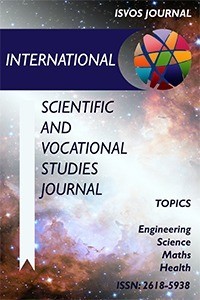The Mesozoic Stratigraphy And Ammonite Fauna Of Ladik-Akdag (Samsun) Territory
Stratigraphy, Biostratigraphy, Ammonodia
The Mesozoic Stratigraphy And Ammonite Fauna Of Ladik-Akdag (Samsun) Territory
Stratigraphy, Biostratigraphy, Ammonodia,
___
- [1] Akay, E. H., Herece, E. ve Ateş, Ş. “Destek (Orta Pontidler) Dolayında Akgöl Formasyonunun Yaş Bulgusu”. MTA Dergisi pp.,116 (1994).[2] Aktimur, T. H., Ateş, Ş., Yurdakul, M. E., Tekirli, M. E. ve Keçer, M. “Niksar-Erbaa ve Destek Dolayının Jeolojisi”. MTA Dergisi no.,114, pp.,25-36, (1992).[3] Akyazı, M. ve Tunç, M. “Zile (Tokat) Yöresinin Stratigrafisi”. TJK Bülteni, no., 35/2, pp.,36-42, (1992). [4] Akyazı, M. “Orta Pontidlerde Yüzeyleyen Örtü Birimlerinin Stratigrafisi”. Cumhuriyet Üniversitesi Bilimsel Araştırma Projeleri. Projeckt no., 447 (Yayımlanmamış), (2013).[5] Akyazı, M. “Kuzey Anadolu Mesozoyik yüzleklerinin karşılaştırmalı stratigrafisi ve Ammonitler”. Cumhuriyet Üniversitesi Bilimsel Araştırma Projeleri. Project no., 643 (Yayımlanmamış), (2017).[6] Altınlı, İ.E. “Bilecik Jurasiği”. Cumhuriyetin 50 . yılı yerbilimleri Kong. Tebliği, no., 103, (1973).[7] Alp, D. “Amasya Yöresinin Jeolojisi”. İ.Ü. Fen Fakültesi Monografileri, no., 22, pp.10, (1972).[8] Atalay, Z. “Amasya Yöresi'ndeki Linyitli Çeltek Formasyonunun Stratigrafisi, Fasiyes ve Çökelme Ortamı Özellikleri”. Türkiye Jeoloji Bülteni. no., 44, pp., 2, (2001).[9] Baykal, F. “Zile -Tokat- Yıldızeli Bölgesinin Jeolojisi”. İ.Ü. Fen Fakültesi Mecmuası, vol., XII, no., 3, pp., 19, (1947).[10] Blumenthal, M. “Beitrage zur géologie der landschaften am miitelcren und unteren Yeşilırmak”. MTA. yayınları. Vol., 4, pp., 183, (1950).[11] Blumenthal, M. “Lâdik deprem hattı”. MTA yayınları, no., 1/33, pp.,153-162, (1943).[12] Erturanc, M, K. “Amasya ve Çevresinin Morfotektonik Evrimi”. Doktora Tezi, İstanbul Teknik Üniversitesi, (2009)[13] Gedik, A., Ercan, T. ve Korkmaz, S. “ Orta Karadeniz (Samsun-Sinop) Havzasının Jeolojisi ve Volkanik Kayaçların Petrolojisi”. MTA Dergisi, no., 99/100, (1984).[14] Gökçe, A. “Turhal Antimon Yataklarının Maden Jeolojisi”. Doktora Tez, Hacettepe Üniversites, (1983).[15] Görür, N., Şengör, A. M. C, Akkök, R. ve Yılmaz, Y. “ Pontidlerde Neo-Tetis'in kuzey kolunun açılmasına ilişkin sedimantolojik veriler”. TJK Bülteni, no.,26, pp., 11-20, (1983).[16] Gözübol, A. M. “Mudurnu - Dokurcun Abant (Bolu ili) alanının jeoloji incelemesi ve Kuzey Anadolu Yarılımının yapısal özellikleri”. İst. Üniv. Fen Fak. Mec., vol.,45, pp., 9-34, (1980).[17] Koçyiğit, A. “Tekneli bölgesinin (Tokat güneyi) tektonik özelliği”. Tübitak Project No: TBAG-262, pp.63, (1979).[18] Minaz, M. “Tokat-Zile-İ.T. 10564 ruhsat nolu linyit sahasına ait fizibilite raporu”. MTA. Enst. Rapor no 40200/1, pp.,16 (Yayınlanmamış), (1984).[19] Okay, A. C. “Sivas ile Tokat arasındaki bölgenin jeoloetüdü”İ. Ü. Fen Fak. Mecmuası, vol., XX, no., 2, pp.,95-108, (1955).[20] Özdemir, Ü. ve Pekmezci, F. “Amasya-Suluova-Çeltek linyit sahaları jeolojisi ve sondaj aramaları raporu”. MTA 116 Yerbilimleri Genel Müdürlüğü Derleme No: 428, pp.,24, (1983).[21] Öztürk, A. “Ladik-Destek yöresinin stratigrafisi”. Türkiye jeoloji Kurumu Bülteni, no., 22, pp.,27-34, (1979).[22] Özcan, A. Erkan, A., Keskin, A,, Keskin, E., Oral, A., Özer, S., Sümengen, M. ve Tekeli, O. “Kuzey Anadolu Fayı ile Kırşehir Masifi arasının temel jeolojisi” MTA Enst. Rapor No: 6722, pp., 139, (1980).[23] Saner, S. “Batı Pontidlerin ve komşu havzaların oluşumlarının levha tektoniği kuramıyla açıklanması, Kuzeybatı Türkiye”. Maden Tetkik ve Arama Enstitüsü Dergisi, no.,93/94, pp., 1-19, (1980).[24] Serdar, H.S., Yarman, M. Kazdal, R.A. ve Namoğlu, C. “Samsun-Ladik-Niksar-Terme (Kuzey Anadolu Fay Zonu) jeolojik etüdü ve petrol olanakları” TPAO Rap. No. 2650, (1984).[25] Seymen, İ. “ Kelkit vadisi kesiminde Kuzey Anadolu fay zonunun tektonik özelliği”, Doktora Tezi, İ.T.Ü. Maden Fakültesi Yayınları no.,192, (1975).[26] Seymen, İ. “Mecitözü dolayının stratigrafik gelişimi”, Suat Erk Jeoloji Simpozyumu Bildirileri, A.Ü. Fen Fak. Jeoloji Müh. Böl., pp.129-141, (1993).[27] Tatar, Y. “Yıldızeli Subaşı Köyü yöresinde tektonik incelemeler”. TJK Bülteni, no., 4, pp., 3-15, (1983).[28] Tüysüz, O. “ Karadeniz’den Orta Anadolu’ya bir jeotravers, Kuzey Neo-tetisin tektonik evrimi”. TPJD Bült. Vol.,5/l, no. 1-33 (1993). [29] Tüysüz, O. “Amasya ve çevresinin jeolojisi”. Türkiye 11. Petrol Kongresi, Bildiriler, Türkiye Petrol Jeologları Derneği/ TMMOB Petrol Mühendisleri Odası/TMMOB Jeofizik Mühendisleri Odası, pp., 32-48(1996).[30] Tetiker, S., Yalçın, H. ve Bozkaya, Ö. “Karakaya karmaşığı (Tokat yöresi) birimlerinin düşük Dereceli metamorfizması”. 14. Ulusal Kil Sempozyumu Bildiriler Kitabı, pp.,155-173, (2009).[31] Toprak, Ö. “Batı-Orta Karadenizde Yüzleyleyen Jura-Kretase Yaşlı Birimlerin Stratigrafisi”. Doktora Tezi s.C.Ü. Fen Bil. Enst., (2014).[32] Üstüntaş, A. ve İnceöz, M. “Zile (Tokat) batısında Uzunköy çevresinin stratigrafisi” Türkiye Jeoloji Bülteni vol., 42, no.,1, pp., 69-83, (1999).[33] Yalçın Erik, N. ve Ay, F. “Tersiyer yaşlı Artova ve Zile kömürlerinin (Tokat) organik jeokimyasal özellikleri ve hidrokarbon türetim potansiyelleri”. H. Ü.Yerbilimleri Dergisi, no., 31-3, pp., 169–190, (2010). [34] Yılmaz, A. “Tokat ile Sivas arasındaki bölede ofiyrj îitlerin kökeni, içyapısı ve diğer bilimlerle ilişkisi”. Doktora tezi, A.Ü, Fen Fakültesi Jeolojisi Kürsüsü, pp., 136, (1980).[35] Yılmaz, Y., Yiğitbaş, E., Yıldırım, M., Genç, Ş. C, Elmas, A., Gürer, Ö. F., Bozcu, M., Gürpınar, O. ve Serdar, H. S. “Geology and development of the Tokat Massif, Second International Turkish geology workshop”, Abstracts, Cumhuriyet Univ., Müh. Fak., Jeol. Müh. Böl., pp., 117, (1995).
- ISSN: 2618-5938
- Yayın Aralığı: Yılda 2 Sayı
- Başlangıç: 2017
- Yayıncı: Umut SARAY
A Reduced Reference Metric for Enhanced 3D Video Perception
Classification and Diagnostic Prediction of Breast Cancers via Different Classifiers
Exterior Scaffolds of Prefabricated Components, Loads Affecting Scaffolds and Scaffold Experiments
Mustafa YAŞAR, Salih YAZICIOĞLU
Optimization of Polyethylene Inserts Design Geometry of Total Knee Prosthesis
Burak ÖZTÜRK, Levent UĞUR, Fehmi ERZİNCANLI, Özkan KÜÇÜK
Fabrication of Glazed Porcelain Using Glass Industry by Product Sodium Feldspar
Volkan ESKİZEYBEK, Bertan BÜYÜKÇINGIL
Removal of Major Impurties (Ca-Mg) of Brine with Chemical Treatment Process in the Salt Sector
Analytical Design of PI Controllers for First Order plus Time Delay Systems
An Exploration of Student Misconceptions in Electrical and Electronics Engineering Department
The Mesozoic Stratigraphy and Ammonite Faune for Niksar-Erbaa (Tokat) Territory
The Mesozoic Stratigraphy And Ammonite Fauna Of Ladik-Akdag (Samsun) Territory
